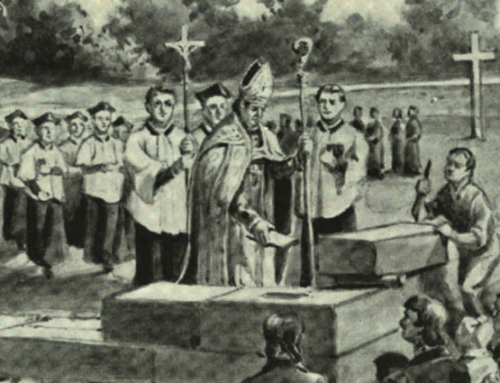 Attempts by the secular state to curtail or crush religious liberty are nothing new. More than four hundred years ago, during the reign of Elizabeth I in England, it was a crime punishable by death to be a Catholic priest and a crime punishable by death to hide a priest from the government’s priest-hunters.
Attempts by the secular state to curtail or crush religious liberty are nothing new. More than four hundred years ago, during the reign of Elizabeth I in England, it was a crime punishable by death to be a Catholic priest and a crime punishable by death to hide a priest from the government’s priest-hunters.
The Elizabethan reign of terror came to an end on March 24, 1603, the queen finally going to meet her reward after ruling tyrannically for more than forty-four blood-soaked years. The total number of those who suffered for their faith during those years is unknown. Those put to death specifically for being priests numbered 126 and those executed for harbouring them numbered 63. This was, however, only the tip of the iceberg. Hidden from view is the countless number of men and women, and even children, who died in the squalor of England’s prisons. The Jesuit William Weston spent seventeen years in prison, and the recusants Francis Tregian and Thomas Pounde were imprisoned for twenty and thirty years respectively. Grace Babthorpe, a neighbor of Margaret Clitherow, the latter of whom was executed for harbouring priests, endured five years of imprisonment, becoming a nun following her release. Apart from the priests put to death for their faith, many others died in prison. About 130 Marian priests (those ordained during the reign of Mary Tudor) were imprisoned in the reign of Elizabeth, with approximately thirty of them, aged and sick, dying in prison. Of the 471 seminary priests who came to England to minister to England’s Catholics during Elizabeth’s reign, 285 were captured and incarcerated.
As for the facts surrounding the queen’s final days and death, there is a contemporary account, written in 1607 by Elizabeth Southwell, a royal maid of the queen who was often in the queen’s presence during the last weeks of her life. Terrified of the approach of death, no doubt haunted by the many crimes she’d committed against her subjects, Elizabeth had taken to the sort of superstition which hinted at witchcraft. She wore a gold amulet around her neck, sent to her by an old woman in Wales who had allegedly been 120 years old when she died, which was said to bestow longevity upon its wearer. The occult trinket notwithstanding, the queen became sick and told Lady Scrope, one of her ladies in waiting, that she had been visited by what she described as an apparition of herself “exceeding lean and fearful in a light of fire.” Prompted by this visitation, the queen commanded that a true looking glass be brought to her, “which in twenty years before she had not seen but only such a one which of purpose was made to deceive her sight.” Horrified at the sight of her own decrepit and aging body, unperceived for two decades, she “took it so offensively that all those which had before flattered her durst not come in her sight.”
Elizabeth was known to daub cosmetics onto her face in ever increasing quantities as she got older, hiding her aging (mortal) face in a mask of youth. A description of Elizabeth at the end of 1600 paints a lurid picture of her painted features: “It was commonly observed this Christmas that her Majesty when she came to be seen was continuously painted, not only all over her face, but her very neck and breast also, and that the same was in some places near half an inch thick.” It was around this time that Shakespeare was working on Hamlet and it is hard to avoid the suspicion that the playwright had Queen Elizabeth in mind in Hamlet’s words to the skull of Yorick: “Now get you to my lady’s chamber, and tell her, let her paint an inch thick, to this favor [i.e. death] she must come.”
Becoming seriously ill in March 1603 and “falling into extremity,” Elizabeth sat for two days and three nights, fearful of sleeping and refusing to eat or drink. Urged by Robert Cecil that she “must go to bed,” the queen responded that the word “must” was not to be used to princes. “Little man, little man,” she told him, “if your father had lived, ye durst not have said so much; but thou knowest I must die and that maketh thee so presumptuous.” Cecil’s father, Lord Burghley, had masterminded Elizabeth’s persecution of her Catholic subjects until his death in 1598, a role that Robert would fulfil in the final years of Elizabeth’s reign and in which he would continue after the accession of King James.
Elizabeth Southwell also mentions the discovery of a playing card, the queen of hearts, which had been nailed to the bottom of the queen’s chair, evidence of witchcraft being used against her by her own treacherous courtiers. Another of her ladies in waiting, Elizabeth Guilford, was shocked to see the queen walking through the palace in the middle of the night. Approaching her to apologize for having left her unattended, the queen’s figure vanished before her eyes. Rushing to the royal bedchamber, she found Elizabeth asleep as she had left her.
Believing that the queen’s death was near, the Privy Council summoned the Archbishop of Canterbury and other senior prelates of the state religion to her presence, “[u]pon sight of whom she was much offended, cholerically rating, bidding them be packing, saying she was no atheist, but knew that they were [illegible word] hedge-priests, and took it for an indignity that they should speak to her.” Although the word preceding the reference to “hedge-priests” is illegible in the manuscript, Elizabeth’s dismissive and derogatory reaction to her own bishops suggests that she considered their priesthood doubtful, a recognition perhaps that Anglican ordination was invalid and that, therefore, the priests of the state religion were illicit. It is little wonder, when racked with such doubts, that she must have feared for the destiny of her soul, which would explain her tortured and torturous last days.
After the queen’s death, she was sealed in a wooden coffin, lined with lead and velvet. Elizabeth Southwell was one of six ladies in attendance at the coffin when the corpse was said to have exploded, the queen’s “body and head brake with such a crack that splitted the wood, lead, and cerecloth!” In consequence, as a grim postmortem and gruesome postscript to the most bloody of lives, Queen Elizabeth’s body had to be stitched together again prior to burial.
As for the lingering legacy of Elizabeth’s cruel reign, let’s allow William Cobbett to wax indignant:
It is hardly necessary to attempt to describe the sufferings that the Catholics had to endure during this murderous reign. No tongue, no pen is adequate to the task. To hear mass, to harbor a priest, to admit the supremacy of the Pope, to deny this horrid virago’s spiritual supremacy, and many other things which an honourable Catholic could scarcely avoid, consigned him to the scaffold and to the bowel ripping knife…. [T]he gallows and gibbets and racks were in constant use, and the gaols and dungeons choking with the victims. See a gentleman of perhaps sixty years of age or more, see him, born and bred a Catholic, compelled to make himself and his children beggars, actual beggars, or to commit what he deemed an act of apostasy and blasphemy….
As to the poor conscientious “recusants,” that is to say, keepers away form the tyrant’s church, they who had no money to pay fines with were crammed into prison until the gaols could (which was very soon) hold no more, and until the counties petitioned to be relieved from the charge of keeping them. They were then discharged, being first publicly whipped, or having their ears bored with a hot iron. This not answering the purpose, an act was passed to compel all “recusants” not worth twenty marks a year to quit the country in three months after conviction, and to punish them with death in case of their return….
The other deeds and events of the reign of this ferocious woman are now of little interest.… Historians have been divided in opinion as to which was the worst man that England ever produced … but all mankind must agree that this was the worst woman that ever existed in England….
The Imaginative Conservative applies the principle of appreciation to the discussion of culture and politics—we approach dialogue with magnanimity rather than with mere civility. Will you help us remain a refreshing oasis in the increasingly contentious arena of modern discourse? Please consider donating now.
The featured image is a portrait of Elizabeth I attributed to Marcus Gheeraerts the Younger or his studio, c. 1595, and is in the public domain, courtesy of Wikimedia Commons. It has been brightened for clarity.







That Elizabeth I questioned the legitimacy of the Anglican priesthood should be exposed should come as no surprise. She was after all an intelligent and educated human being. She was also raised as a Roman Catholic. The Anglican Church in the 21st century is still seeking its own legitimacy and has failed utterly to solve the divisions in its own ranks. Notwithstanding, the legal cruelty that was part of her reign was for the most part a continuation of Henry VIII excesses and it was exacerbated by the movement started by Luther and others — not to mention the powerful political effects of the Inquisition and religious civil war raging on the Continent. Phillip of Spain’s attempted invasion of course did not help matters. Many years ago, I was assisting my father with stonework repairs to the belfry of our medieval village church, when I noticed an inscription on one of the bells — it stated ‘Long live good queen Bess.’ It spoke volumes as to how the ordinary people felt about their queen.